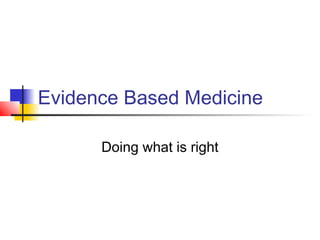
Evidence based medicine
- 1. Evidence Based Medicine Doing what is right
- 2. Definition Conscientious, explicit, judicious use of current best evidence in making decisions about care of an individual patient Involves integrating individual clinical experience with best external evidence from systematic research
- 3. Types of EBM Evidence based guidelines- production of guidelines, policy and regulations to be used at the organizational or institutional level Evidence based individual decision making- use of available evidence to provide best treatment to an individual patient, by an individual physician
- 4. Answering clinical question Formulate a question Search the literature Evaluate the literature Apply available evidence in management
- 5. Stratifying evidence Prospective, randomised, double-blind placebo controlled trial Prospective, randomised double-blind comparative trial Systematic review- Meta-analysis Prospective controlled trial, without randomisation Sub-group analysis or Retrospective study Uncontrolled trials- Cohort/Case-control studies Case series or case reports Expert opinion
- 6. Levels of evidence I- from at least one RCT II- from controlled trials without randomization, multicentric case-control or cohort studies or uncontrolled trials III- opinions of respected authorities, based on clinical experience or reports of expert committees
- 7. Categories of recommendation A- good scientific evidence that benefits >>> potential risks B- fair scientific evidence that benefits >> potential risks C- fair scientific evidence that benefits > potential risks D- fair scientific evidence that risks > benefits I- insufficient scientific evidence
- 8. Clinical trial Study done to allow safety and efficacy data to be collected for health interventions Needs a protocol Investigators recruit patients, administer treatment, collect data over specified time period Data is analysed using statistical tests
- 9. Types of Clinical trials Prevention trial Screening trial Diagnostic trial Treatment trial Quality of life trial Compassionate use trial
- 10. Terms Randomised- subjects are randomly assigned Double-blind- subjects and researchers do not know the treatment being given, to prevent any bias Placebo controlled- use of placebo helps isolate the effect of study treatment
- 11. Phases of Clinical trials Pre-clinical studies- in-vitro or animal studies to obtain preliminary efficacy, toxicity and pharmacokinetic data Phase 0- subtherapeutic doses to few patients to get pharmacokinetic and pharmacodynamic data
- 12. Phases- contd. Phase I- assesses safety, tolerability and dose range in healthy volunteers Phase II- assesses dose and efficacy in a larger group of volunteers and patients Phase III- randomised controlled multicenter trials on large patient group for effectiveness of the treatment Phase IV- post-marketing safety surveillance
- 13. Statistical terms p-value- <0.05 considered significant Relative risk- risk of an event relative to exposure Hazard ratio- ratio between the predicted hazard for members of two groups Odds ratio- ratio of the odds of an event occurring in one group to the odds of it occurring in another group
- 14. Statistical terms- contd. SeNsitivity- probability of a positive test result in someone with target disease i.e. true Positive SPecificity- probability of a negative test result in someone without the disease i.e. true Negative
- 15. Statistical terms- contd. Number needed to treat (NNT)- number of patients needed to treat to prevent one clinical event NNT= 1/absolute risk reduction Number needed to harm (NNH)- for harmful effects of the treatment
- 16. Quality of Clinical trials Clearly defined eligibility criteria and have minimal missing data Results must be generalizable in clinical practice Adequate follow-up for defined outcomes to occur and to detect differences between arms of study Sufficient number of patients to detect a significant difference
- 17. Limitations Ethical issue of offering or not, of an unproven treatment Cost of trial and consequent source of funding Generalizability, comparability and extrapolation of results Publication bias Use for rationing resources by economists, policymakers and managers Availability of credible evidence Applying statistics to individuals
